- Insights
Monthly Market Brief (November 2025)
MACROS
In November 2025, the Central Bank of Nigeria (CBN) maintained a restrictive monetary policy stance, signaling a measured approach toward sustaining price stability and anchoring market expectations. At the 303rd Monetary Policy Committee meeting, the CBN held the Monetary Policy Rate at 27.0% and retained the Cash Reserve Requirement for deposit money banks at 45%, reflecting its commitment to liquidity sterilization and broader disinflationary objectives. The Standing Facility corridor was adjusted to +50/-450 basis points, a technical refinement designed to improve short-term liquidity management and tighten the transmission of policy signals to the money market.
The retention of the MPR followed the first-rate adjustment since September, demonstrating the MPC’s preference for caution. Policymakers emphasized that the cumulative effects of previous tightening cycles are still unfolding, and premature easing could undermine gains in inflation control and destabilize the foreign exchange market by weakening the yield differential that attracts portfolio inflows. This approach reflects the dual mandate of controlling inflation while preserving external sector stability.
October CPI data indicated continued disinflation, with headline inflation moderating to 16.05% year-on-year and month-on-month price growth slowing to 0.90%. However, underlying structural pressures persist. Core inflation, which excludes volatile food and energy components, remained elevated at 18.70%, driven by sustained cost pressures in housing, utilities, and transportation. Food inflation, at 13.12%, reflects the vulnerability of the agricultural sector to security challenges, including banditry and logistics disruptions, which continue to exert upward pressure on prices despite monetary tightening.
Inflation Trajectory
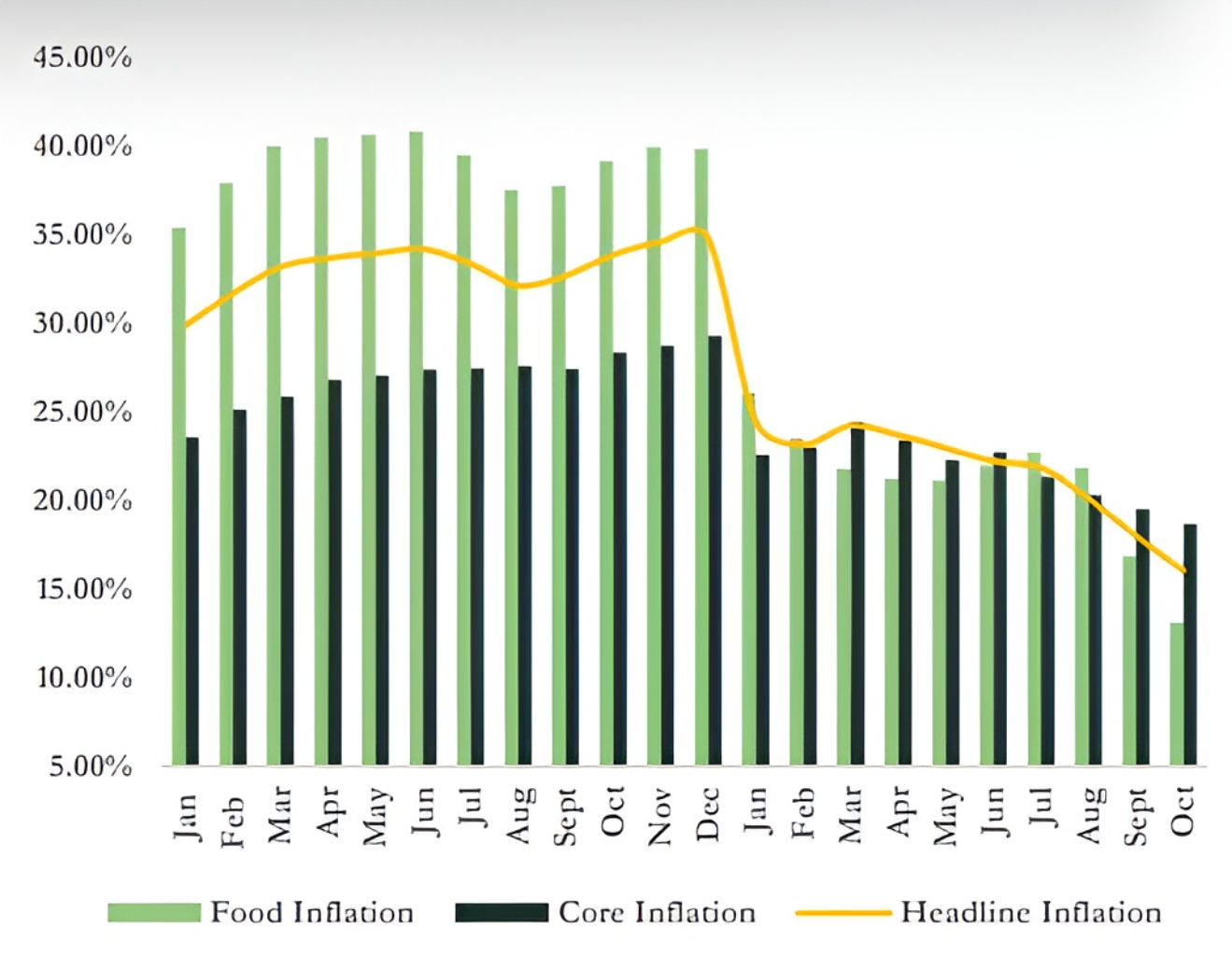
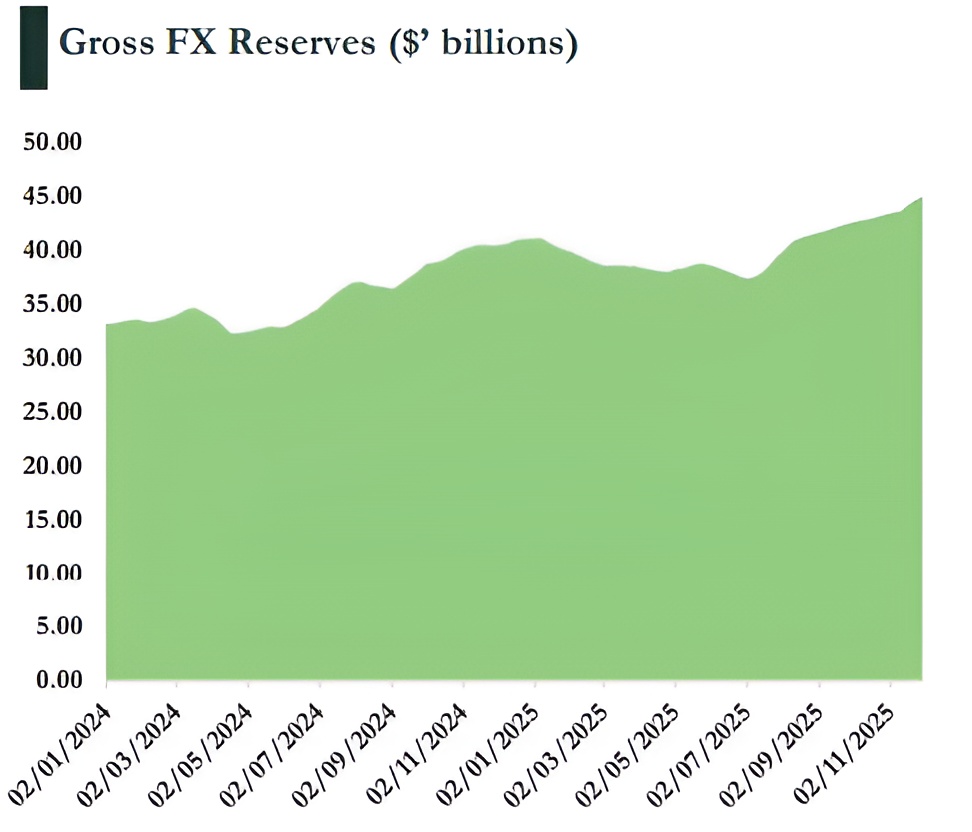
In November 2025, the Nigerian foreign exchange market continued to consolidate stability, reflecting the effectiveness of the CBN’s unification and market-driven reforms. The Naira traded steadily around the mid-₦1,440/US$ range, posting a monthly depreciation of -1.34%. The elimination of the chronic arbitrage
premium underscores the success of structural reforms, enhancing investor confidence and supporting efficient market functioning.
The currency’s resilience was underpinned by a combination of restrictive monetary policy, robust foreign portfolio inflows, and structural measures to expand non-oil FX supply, including the NRBVN platform to facilitate diaspora remittances. High interest rates remain a key tool in attracting capital, though they create a structural reliance on foreign inflows for stability.
Nigeria’s external sector strengthened markedly, with Gross External Reserves rising to US$46.7 billion by mid-November, equivalent to 10.3 months of import cover. The successful US$2.35 billion Eurobond issuance contributed to reserve accumulation, reinforcing Nigeria’s capacity to absorb external shocks and maintain macroeconomic stability
EQUITIES
The Nigerian equity market in November 2025 experienced a sharp correction as fiscal policy uncertainty and restrictive monetary conditions combined to trigger widespread profit-taking and capital flight. The NGX All-Share Index dropped from 154,126.46 points at the end of October to 143,520.53 points by 28 November, reflecting a month-to-date decline of 6.88%. Similarly, market capitalization shrank by ₦6.54 trillion, declining from ₦97.83 trillion to ₦91.29 trillion. Despite the pullback, the year-to-date gain remained positive at 39.44%, still lower than the 49.74% recorded at the end of the previous month, reflecting the strong rally seen earlier in 2025.
The market downturn was primarily driven by profit-taking activities and the government’s announcement of an increase in the capital gains tax for foreign investors from 10% to 30% on non-reinvested equity sales, effective January 2026, which prompted foreign portfolio investors to realize gains under the existing lower tax regime. Concurrently, the Central Bank of Nigeria maintained a rigid monetary tightening stance, keeping the Monetary Policy Rate at 27.0%, further discouraging equity speculation and sustaining pressure on valuation multiples.
NGX ASI Monthly Returns
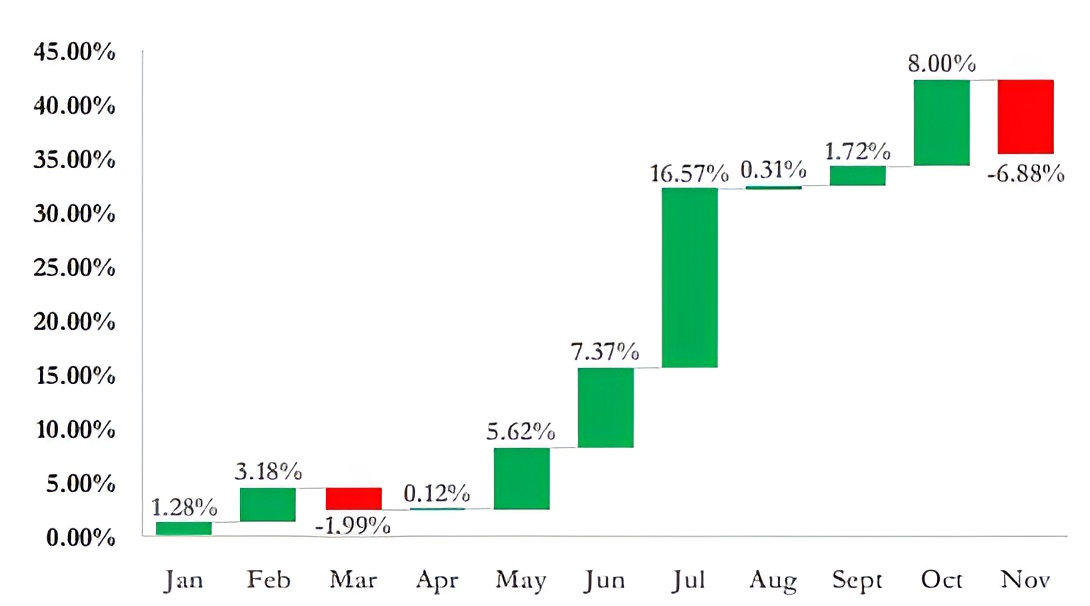
Sectoral performance across the Nigerian Exchange in November 2025 reflected a broad-based market retreat driven by sharp foreign portfolio outflows and sustained monetary tightening. The Industrial Goods Index recorded the steepest decline at –13.81% (vs. +17.50% in October), as major cement names, DANGCEM (–19.00%), BUACEM (–11.11%), and WAPCO (–4.29%), faced heavy selloffs following the announcement of the 30% capital gains tax on nonreinvested foreign equity sales. Earlier valuation gains, boosted by FX-driven earnings expansion, unwound quickly under higher discount-rate conditions.
The Banking Index fell –5.77% (vs. –3.15%), pressured by broad profit-taking and portfolio repositioning. Tier-1 names such as ACCESSCORP (–14.11%), GTCO (–12.28%), UBA (–8.99%), Zenith (–4.76%), and WEMA (–10.51%) declined as elevated liquidity constraints, particularly the 45% CRR, kept funding conditions tight. Although strong earnings fundamentals encouraged intermittent bargain hunting, they were insufficient to offset overall downside momentum.
NGX ASI Historical Performance

Consumer Goods slipped –3.20% (vs. +4.85%), reflecting a relatively defensive pullback. Losses in Champion (–17.33%), Nestle (–7.05%), Cadbury (–7.43%), and DangSugar (–7.60%) weighed on the index, though domestic-focused midcaps such as Unilever showed resilience and helped drive a mild late- month rebound, including a 0.57% uptick on November 28.
The Oil & Gas Index contracted –7.33% (vs. +15.45%), driven by profit-taking in ARADEL (–11.76%) and OANDO (–19.15%) amid weaker sentiment toward energy names due to global crude uncertainty and domestic macro risks. Insurance posted one of the sharpest declines at –12.06% (vs.+3.37%), as risk aversion triggered broad sell pressure across small- and mid-cap counters. AIICO (-15.35%), NEM (14.74%), and MBENEFIT (- 13.95%) were the major drivers of the loss.
Overall, November’s performance was dominated by aggressive divestment linked to fiscal policy signals, particularly the CGT announcement, overshadowing sectorspecific fundamentals. While select rebounds emerged toward the month-end, sectoral dynamics remained shaped by tight monetary conditions, fragile investor sentiment, and a pronounced rotation away from high-beta Nigerian equities.
NGX Sectoral Returns in November
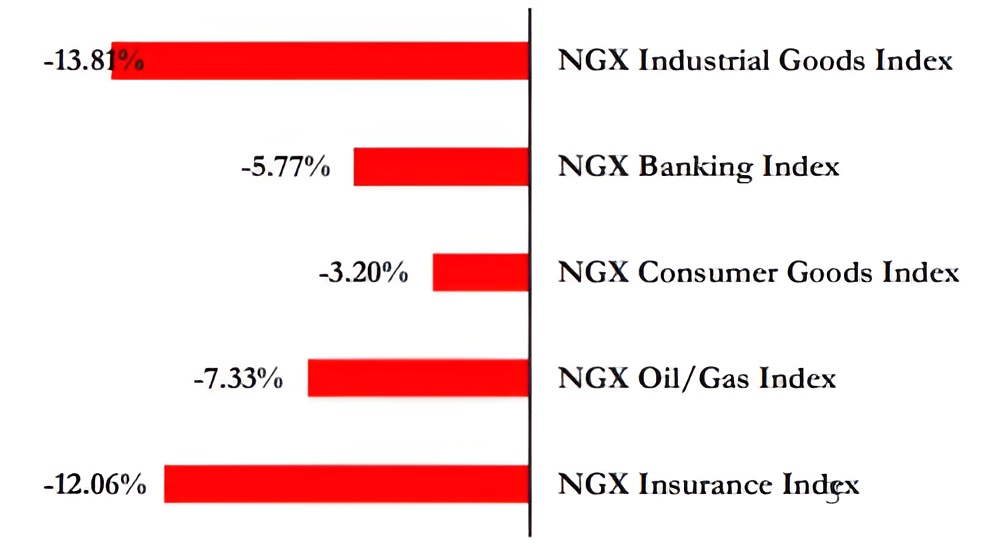
In line with this broad weakness, several blue-chip counters were also among the worst-performing stocks for the month, reflecting the heavy divestment pressure triggered by the CGT announcement.
High-beta, foreign-held names such as DANGCEM (–19.00%), ACCESSCORP (–14.11%), GTCO (–12.28%), UBA (–8.99%), Zenith Bank (–4.76%), and NESTLE (–7.05%) saw sharp declines as investors exited large-cap positions to rebalance risk.
Nonetheless, a few tickers bucked the trend, with NCR (+241.56%), Ikeja Hotel (+60.90%), Eunisell (+37.29%), and UACN (+18.65%) emerging as notable outperformers, largely driven by companyspecific developments and their previously low-price levels, rather than the overall market trend.
Outlook
Market sentiment entering December is expected to remain cautious, despite the federal government’s clarification of the 30% CGT, which introduced key provisions such as grandfathering for pre-2026 gains, exemptions for retail portfolios below ₦150 million, and reinvestment relief. This will ease investor anxiety and create room for cautious re-entry, though liquidity remains tight and macroeconomic conditions continue to limit risk-taking. The rollout of the CBN’s new fixed-income trading and settlement framework will also be closely watched, as any operational disruptions could affect secondary-market liquidity and influence portfolio positioning.
Despite these headwinds, December may still benefit from seasonal drivers such as dividend positioning, year-end rebalancing, and selective bargain-hunting following November’s valuation reset. However, sustained recovery will depend on consistent policy execution, improved communication, and early signs of monetary easing. Until these conditions improve, overall market posture is likely to remain defensive, with investors prioritizing stability while gradually rebuilding exposure ahead of the 2026 trading year.
FIXED INCOME
Domestic Money Market and System Liquidity
The Nigerian Treasury Bills (NTB) market in November 2025 recorded strong, yield-sensitive demand as investors sought safety amid heightened equity-market volatility and tight monetary conditions. Elevated system liquidity and attractive sovereign yields supported aggressive bidding across all tenors, particularly the 364-day maturity, as investors aimed to lock in double-digit rates ahead of potential monetary policy adjustments in early 2026. Throughout the month, the primary market remained a key destination for domestic institutional funds, reflecting a strategic reallocation toward risk-free assets.
The early-November auction on November 5 set the demand tone for the month, with stop rates clearing at 15.30% (91-day), 15.50% (182-day), and 16.04% (364-day). Despite relatively modest issuance sizes, subscription levels, especially the ₦1.14 trillion demand for the 364-day bill, far exceeded offer amounts, underscoring the strength of investor appetite for longer tenor bills. The tight bidding bands reflected disciplined pricing, driven by expectations that yields were near their cyclical peak and could moderate in subsequent months. These conditions led investors to prioritize locking in term yields while seeking tactical duration exposure.
A major inflection in the yield environment emerged in mid-to-late November following the Monetary Policy Committee’s decision to maintain the MPR at 27.0%, which helped stabilize rate expectations. This policy continuity enabled the CBN to engineer a substantial downward adjustment in stop rates during the November 19 auction. The 364-day rate dropped sharply to 16.04%, a notable decline from the 20%+ levels recorded in mid-month auctions, while subscription still reached ₦1.03 trillion (2.3x oversubscription). The successful rate compression demonstrated the CBN’s capacity to exert decisive
control over front-end yields, exploiting deep domestic liquidity to reduce government borrowing costs while maintaining strong participation.
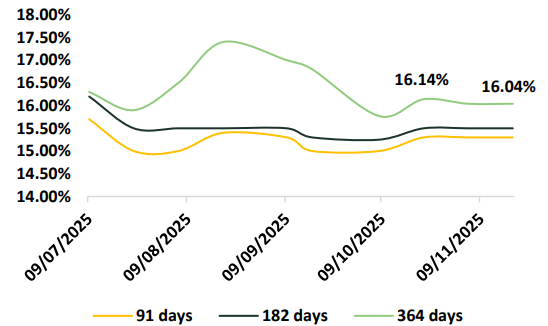
Eurobonds and Global Confidence
Nigeria’s engagement with the international capital markets in November 2025 was defined by a strong primary issuance outcome juxtaposed against renewed secondary-market volatility. The country’s US$2.35 billion Eurobond deal, issued across 10-year and 20-year tranches, attracted exceptionally strong investor interest, reflecting ample global liquidity and sustained appetite for high-yielding emerging-market sovereign debt. However, the supportive issuance backdrop contrasted with a wider recalibration of risk premiums in secondary trading as global conditions became less favourable toward emerging-market assets.
The primary issuance on 5 November 2025 saw Nigeria successfully price US$1.25 billion of 10-year notes at 8.625% and US$1.10 billion of 20-year notes at 9.125%. Demand was exceptionally robust, with the order book reportedly surpassing US$13 billion, translating to roughly 12x oversubscription, one of the largest ever recorded for a Nigerian sovereign sale. While the strong subscription secured the government’s target capital for deficit financing, the elevated pricing levels underscored that investor enthusiasm was overwhelmingly yield-driven. Despite the large order book, markets required materially high coupons to compensate for Nigeria’s fiscal vulnerabilities, reserve adequacy concerns, and broader macro risk environment.
In contrast to the upbeat primary-market experience, Nigeria’s existing Eurobonds posted mixed performance throughout November. Secondary market yields widened by 32 basis points on average, closing at 7.97%, reflecting renewed selling pressure across the curve. This repricing indicated that the market remained sensitive to shifts in global risk appetite, with investors demanding additional term premium to hold Nigerian debt despite the successful primary issuance. The divergence between primarymarket strength and secondary-market weakness further highlights the distinction between issuance-driven liquidity dynamics and underlying credit-risk perceptions.
Two key external factors shaped this upward yield drift. First, a strengthening of the U.S. dollar contributed to modest shifts away from emerging-market hard-currency bonds, raising funding costs for sovereigns like Nigeria. Geopolitical tensions between the United States and the Nigerian government also pushed yields higher. After the U.S. issued strong political warnings about Nigeria’s internal security situation, investors became more cautious. The resulting increase in yields illustrates Nigeria’s structural sensitivity to non-economic shocks and underscores the risks inherent in relying heavily on Eurobond financing. As global conditions remain fluid, Nigeria’s external debt trajectory will depend increasingly on stabilizing domestic macro fundamentals and rebuilding investor confidence in its long-term credit outlook.
FIXED INCOME
The Federal Government of Nigeria (FGN) conducted bond auctions on November 24, 2025, offering ₦230 billion each of the 17.945% FGN AUG 2030 (5-Year) and 17.95% FGN JUN 2032 (7-Year) bonds. Subscription levels highlighted stronger investor interest in the medium-term tenor: the 7-Year bond recorded a subscription of ₦509.392 billion, compared to ₦147.869 billion for the 5-Year bond. Successful allotments amounted to ₦448.722 billion and ₦134.799 billion, respectively, reflecting moderate oversubscription for both instruments.
Yields were set at 15.900% for the 5-Year bond and 16.000% for the 7-Year bond, below the initial coupon rates, signaling effective yield management by the Debt Management Office (DMO). The noncompetitive allotment of ₦6.0 billion for the 7-Year bond also underscores continued demand from smaller investors and domestic institutions.
The auction outcomes suggest stabilizing borrowing costs for the federal government, with minimal upward pressure on yields. Coupled with recent trends in T-Bills and short-term securities, the results indicate a coordinated approach to maintaining domestic debt market stability, reflecting investor confidence in Nigeria’s debt instruments amid prevailing macroeconomic conditions.
OUTLOOK
The Nigerian fixed-income market is set for a gradual recalibration. With the CBN maintaining tight monetary conditions and ample liquidity, short-term NTB yields are expected to ease, providing investors with opportunities to secure attractive returns ahead of potential rate adjustments. Demand for longer-dated government bonds remains robust, supported by stable coupon payments and potential capital appreciation in a moderating yield environment.
Fiscal discipline and strategic debt management will be key. A shift toward lower-cost, long-dated instruments, including diaspora bonds, Sukuk, or green bonds, combined with efforts to diversify non-oil revenues, could enhance debt sustainability and bolster investor confidence. This outlook depends on continued macro stability, easing inflationary pressures, and contained external debt risks.
On the external front, while Eurobond issuances have drawn strong demand, global rate dynamics and geopolitical risks could pressure yields, underscoring the need for vigilance. Overall, highyield, long-term government debt is likely to remain a preferred allocation in the near to medium term, contingent on stable macro fundamentals and consistent policy execution.
- Report
Post MPC Meeting Report (November Meeting)
MPC RETAINS INTEREST RATE AMID DISINFLATIONARY TREND
The Monetary Policy Committee (MPC) of the Central Bank of Nigeria concluded its 303rd meeting on November 25, 2025, delivering a policy stance characterized by headline rate stability and technical tightening through adjustments to operational tools. While the benchmark rate was held constant, the recalibration of the asymmetric corridor signals a continued commitment to disinflation, FX stability, and prudent liquidity management.
Policy Decisions and Rationale
The MPC opted for continuity in its primary policy levers:
- MPR: Retained at 27.00%, reinforcing the CBN’s tight monetary posture.
- CRR: Maintained at 45% for DMBs, 16% for merchant banks, and 75% for non-TSA public sector deposits
- Liquidity Ratio: Held steady at 30%.
- Asymmetric corridor was adjusted to +50/-450bps from the previous +250/-250bps around the MPR
The most notable action was the adjustment of the asymmetric corridor to +50/-450 bps around the MPR, resulting in a 27.5% Standing Lending Facility (SLF) and a 22.5% Standing Deposit Facility (SDF). This shift away from the previously wider symmetric corridor effectively tightens the lower bound of system liquidity, discouraging excess reserves and strengthening monetary transmission. The Committee emphasized that maintaining this stance allows the lagged effects of earlier rate hikes to permeate the economy, given the ongoing disinflationary trend.
Inflation continued its steady downward trajectory in October 2025, marking the seventh consecutive month of disinflation. Headline inflation declined to 16.05% (y/y) from 18.02% in September, reflecting broad-based moderation across both food and core components.
Food inflation eased sharply to 13.12% from 16.87% in the previous month. This improvement was supported by improved domestic food supply associated with the seasonal harvest cycle, sustained exchange rate stability, and favourable base-year effects. Meanwhile, core inflation slowed to 18.69% (y/y) from 19.53%, driven largely by lower prices in furnishing and household maintenance categories.
Inflation Trend Y-o-Y

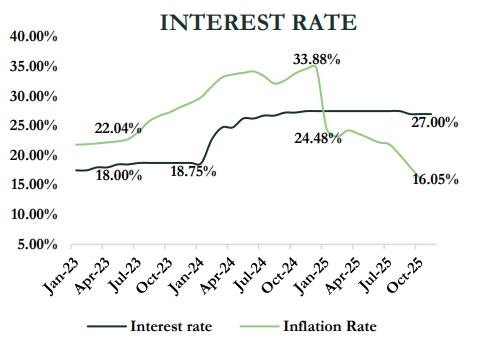
Despite these positive developments, the MPC emphasized that inflation remains elevated in double digits, underscoring the need for persistent policy vigilance to sustain and deepen the disinflation trend. The MPC noted that the broad-based deceleration across headline, food, and core measures reflects the combined effect of past tightening, exchange-rate stabilization, and improved domestic supply conditions. The Committee expects this disinflationary momentum to persist into the near term.
The MPC’s emphasis on persistently high core inflation, which remains above the headline rate, reinforces the view that underlying price pressures are structural rather than transitory. This validates the Committee’s cautious posture and signals that broad monetary easing will not commence until inflation expectations are firmly anchored and macroeconomic stability is consolidated.
The Global View
On the global front, the CBN assessed a cautiously improving environment. Global output is projected to strengthen on improved trade negotiations, accommodative policies in advanced economies, and easing geopolitical tensions. However, risks remain from potential protectionism, geoeconomic fragmentation, and renewed U.S.–China trade frictions. Global inflation is projected to continue moderating into 2026.
Domestically, the MPC highlighted the strong external sector position, supported by a surplus current account, continued reserve accretion, and Stable FX market conditions. These improvements, alongside collaborative fiscal–monetary reforms, supported recent upgrades to Nigeria’s sovereign rating and the country’s delisting from the FATF grey list, strengthening investor confidence.
Market Impact
The MPC’s decision to hold the MPR at 27% disrupted expectations for a sizeable rate cut, preventing the
significant yield compression previously anticipated across the money and bond markets. This outcome stabilizes fixed-income pricing by reducing immediate downside risk to asset values and provides clearer rate visibility after recent market volatility.
In the Treasury Bills and OMO segments, yields are expected to remain elevated. The latest auction results show the 364-day NTB marginal rate at 16.04%, broadly aligned with headline inflation at 16.05%. This ensures short-term instruments continue to deliver attractive real returns, supporting strong investor demand under the high-interest-rate environment.
From a portfolio positioning standpoint, the policy hold reinforces an Overweight bias toward short- to mid-tenor sovereign securities, where yields remain compelling and liquidity conditions tight. Demand for NTBs, OMOs, and 3–7-year FGN bonds is expected to stay robust, given banks’ need to manage liquidity under elevated CRR pressures and limited alternative outlets.
Equity market implications are mixed. A selective approach is warranted, emphasizing fundamentally strong, dividend-paying companies with sustainable pricing power. Large-cap banks are likely to maintain earnings resilience through elevated net interest margins, while firms with significant FX revenues stand to benefit from exchange-rate stability. Conversely, highly leveraged manufacturers and consumer-facing companies reliant on expensive domestic credit remain vulnerable under the prolonged tight monetary stance.
Outlook
The Committee projects that disinflation will continue in the near term, driven by the lagged effects of previous policy tightening, stable FX conditions, and improved domestic food supply associated with the seasonal harvest cycle. However, inflation remains elevated, and the MPC is expected to maintain a restrictive stance until a more durable decline in core and headline inflation is secured.
For financial markets, this suggests a continued environment of high yields, tight liquidity, and selective risk-taking. Fixed-income valuations will remain anchored by the elevated policy rate, while equity performance will diverge along sectoral and balance-sheet strengths.
The next MPC meeting is scheduled for February 23–24, 2026, where the trajectory of inflation, FX stability, and fiscal alignment will determine whether current tightening is sustained or provides room for cautious policy recalibration.
- Insights
Monthly Market Brief (October 2025)
MACROS
Disinflation and FX Stability Strengthen Market Confidence
Nigeria’s macroeconomic landscape underwent a decisive re-anchoring in October 2025, driven by sustained disinflation, improved FX stability, and major sovereign risk reductions. The removal of Nigeria from the FATF grey list marked a critical turning point, materially lowering compliance friction for cross-border transactions and restoring investor confidence in the country’s financial governance architecture. These structural improvements, underpinned by renewed access to Eurobond markets, strengthened external buffers and provided a more predictable macroeconomic environment for both domestic and offshore investors.
Disinflation remained the centerpiece of market confidence, with headline inflation moderating for the sixth consecutive month to 18.02%, its lowest level since mid-2022. Food and core inflation continued to soften, reflecting reduced currency pass-through and more stable price formation. Through this period, the CBN maintained a tight monetary stance, holding the MPR at 27.00% and preserving a strong positive real interest rate. This combination of anchored FX markets and high real returns sustained robust foreign portfolio inflows and reinforced expectations that Nigeria is nearing the end of its monetary tightening cycle.
Inflation Trajectory

FX Driven by Reserve Accumulation and Cautious Policy Easing
The Nigerian currency market in October 2025 consolidated its stabilization trend, supported by improved foreign exchange liquidity, strengthened external reserves, and a cautiously moderated monetary stance from the Central Bank of Nigeria. Throughout the month, th Naira maintained a firm performance in the Nigerian Foreign Exchange Market, benefitting from sustained inflows and a more orderly price formation environment. The official exchange rate appreciated modestly, closing October at approximately ₦1,421 per U.S. Dollar, marking one of its strongest levels since the operationalization of the electronic FX trading framework. This reflected the combined effect of improved supply conditions and heightened investor confidence following Nigeria’s reinforced macro stability narrative.
Gross FX Reserves ($’ billions)

The availability of FX in the official market was bolstered by rising capital importation, particularly Foreign Portfolio Investment attracted to Nigeria’s positive real interest rate environment, and improved dollar inflows from the oil sector, which recorded a notable recovery during the year. These fiscal adjustments complemented monetary tightening to reinforce a more balanced foreign exchange liquidity profile.
A critical anchor for the Naira’s stability during the month was the continued accumulation of external reserves. Gross external reserves strengthened from roughly $42.26 billion at the end of September to an estimated $43.15 billion at the close of October, reflecting almost $900 million in net reserve accretion. This improvement enhanced the central bank’s capacity to meet legitimate FX demand and significantly reduced speculative pressures in both the official and parallel markets. The strengthened reserve position also supported the broader policy narrative that Nigeria’s external balances were becoming more resilient, a development that reinforced confidence across the investment community.
Although the Central Bank did not convene a Monetary Policy Committee meeting in October, market conditions continued to adjust to the earlier reduction in the Monetary Policy Rate to 27.00%. The September rate cut, the first in five years, signalled a cautious shift toward policy easing, made possible by sustained disinflation and greater FX stability. Even with the reduction, the 27.00% MPR remained sufficiently high to maintain Nigeria’s competitive carry advantage, encouraging further portfolio inflows. The Cash Reserve Ratio remained elevated, absorbing substantial liquidity from the banking system and helping to maintain disciplined monetary conditions consistent with the central bank’s broader stabilization objectives.
EQUITIES
Sustained Bull Momentum and Strategic Capital Rotation
The Nigerian bourse (NGX) closed October 2025 on a bullish note, extending its strong year-long performance and ranking among the world’s best-performing equity markets. The month was driven by
significant institutional capital rotation and renewed investor appetite for blue-chip stocks, whichmpushed the NGX All-Share Index (ASI) beyond the 150,000-point psychological threshold. The ASI rose by about 8.00% month-on-month (MoM) to close at 154,126.46 points, compared to a modest 1.72% gain in September. Consequently, market capitalization increased by ₦7.25 trillion, from ₦90.58 trillion in September to ₦97.83 trillion in October, reflecting substantial wealth creation within the period. This strong monthly advance accelerated the Year-to-Date (YTD) return to approximately 51.22%, up from about 41.80% in September, cementing the market’s leadership position globally.
This strong performance positioned October as the second-best month of 2025, behind the notable 16.57% rally recorded in July. The sustained rally highlights investors’ confidence in the resilience and value of Nigerian corporates despite high interest rates and declining fixed-income yields that would ordinarily divert liquidity away from equities.
NGX ASI Monthly Returns

Sectoral performance in October 2025 was broadly bullish, reflecting a distinct flight to quality as investors rotated capital into sectors with stronger earnings visibility and defensive fundamentals. The Industrial Goods Index (+17.50%) led the market, buoyed by institutional accumulation in cement and manufacturing stocks such as Dangote Cement (+26.64%), WAPCO (+15.91%), and BUA Cement (+12.50%),
supported by positive Q3 earnings and improved sentiment following Dangote Cement’s expansion into the Ivory Coast.
Similarly, the Oil & Gas Index (+15.45%) benefited from rising global oil prices and large institutional trades concentrated in premium tickers like Aradel Holdings (+41.30%), Eterna (+29.08%), and Seplat (+10.00%), positioning the sector as a hedge against inflation and currency weakness. This suggests large-scale, sustained accumulation by major domestic institutional investors, such as pension funds, alongside possibly increased interest from sophisticated international investors seeking exposure to high-quality, fundamentally sound equity assets amidst global risk environments. This capital inflow demonstrates confidence that corporate earnings will continue to outpace macroeconomic volatility.
NGX ASI Historical Performance

The Consumer Goods Index (+4.85%) also advanced, driven by solid Q3 earnings expectations and pricing resilience from major firms including PZ (+21.74%), NASCON (+18.65%), and Vitafoam (+17.79%), while the Insurance Index (+3.37%) gained on the back of renewed interest in NEM (+19.64%) and
Mansard (+7.71%).
In contrast, the Banking Index (-3.15%) was the only major laggard, reflecting profit-taking and capital reallocation rather than a fundamental sectoral decline. Following less impressive Q3 earnings, institutional investors strategically reduced exposure to Tier-1 banks such as Zenith Bank (-8.70%), GTCO (-4.69%), and Access Holdings (-4.68%) amid uncertainty surrounding regulatory capital recapitalization and liquidity demands. This selective sell-off underscores a deliberate shift in investor positioning, monetizing gains in liquid banking stocks to fund high-conviction moves into industrial and commodity-linked equities.
NGX Sectoral Returns in October

Sustained Bull Momentum and Strategic Capital Rotation
The list of the worst-performing stocks was dominated by small-to-mid cap equities that were acutely sensitive to weak corporate earnings, liquidity risk, and sector-specific challenges. The massive sectoral appreciation in Industrial Goods and Oil & Gas necessitates that the underlying bellwether stocks in these sectors deliver exceptional returns.


Outlook
In November, market activity is expected to be guided by an interplay of supportive corporate fundamentals and near-term risk triggers. On the upside, the release of 9M:2025 earnings across sectors is expected to drive further repricing of strong-performing stocks. A supportive macroeconomic environment, marked by easing inflation, stable interest rates, and rising oil prices, should help sustain valuations. Institutional investors are likely to maintain interest in fundamentally strong, high-quality stocks as a haven amid global uncertainty.
Sectoral momentum remains skewed toward industrials, oil & gas and consumer goods, while banking may continue to underperform amid regulatory and capital pressures. Investors should monitor key triggers, upcoming earnings prints, inflation and rate surprises, FX/naira developments, and policy-tax changes, which could either reinforce the bullish trend or prompt liquidity tightening.
However, the risk of profit-taking remains elevated: stocks that have delivered outsized gains may experience fund outflows, and uncertainties around the proposed Capital Gains Tax (CGT) could lead foreign and institutional investors to take pre-emptive positions out of the market.
FIXED INCOME
Disinflation and FX Stability Strengthen Market Confidence
October 2025 witnessed notable developments in the Nigerian fixed income market, shaped by dynamic liquidity conditions, active central bank interventions, and strong investor participation in both Treasury
Bills (NTBs) and Federal Government of Nigeria (FGN) Bond auctions. System liquidity experienced significant fluctuations, prompting continued monitoring and management by the Central Bank of Nigeria
(CBN) to maintain the restrictive monetary policy stance set by the 27.00% Monetary Policy Rate (MPR).
Investor appetite remained robust across primary auctions, particularly for longer-dated FGN Bonds, while secondary market activity reflected strategic positioning ahead of primary market events. Yield curve dynamics revealed an inversion in the nominal term structure, signaling market expectations of future monetary easing.
Domestic Money Market and System Liquidity
In October 2025, the Nigerian money market experienced significant liquidity fluctuations. Market liquidity started the month at ₦7.11 trillion on October 2, declined to ₦3.79 trillion by October 8, and later adjusted to ₦2.2 trillion on October 14 following Open Market Operation maturities. Despite these swings, the Central Bank of Nigeria (CBN) maintained a restrictive monetary stance, ensuring that the system
remained tightly controlled and that temporary liquidity surges did not spill over into unintended monetary easing or foreign exchange volatility.
The CBN successfully anchored short-term interest rates throughout the month. The benchmark Open Buy Back (OBB) rate remained at 24.50%, while the Overnight (O/N) rate was tightly managed between 24.87% and 24.88%. These actions demonstrate the effectiveness of the CBN’s sterilization operations in absorbing excess liquidity and preserving the policy objectives set by the 27.00% Monetary Policy Rate.
Investor demand for Treasury Bills remained robust, highlighting strong confidence in risk-free government instruments. The October 8 NTB auction, offering ₦570 billion, was oversubscribed with ₦1.06 trillion in bids, while the October 22 auction saw ₦650 billion offered across three tenors and total bids of ₦750.91 billion. The 364-day bill cleared at a stop
rate of 16.14%, yielding 19.25%, above headline inflation but below the MPR, reflecting a deliberate strategy by the CBN to encourage banks to hold short-term government paper and limit speculative pressures in the broader market.
FGN Bond Market Review
The FGN Bond market drew significant attention, with the DMO offering ₦260 billion through the re-opening of the 5-year AUG 2030 and 7-year JUN 2032 bonds. Investor participation was exceptionally
strong, totaling ₦1.27 trillion, with demand heavily concentrated in the 7-year tenor, which was oversubscribed by more than eight times. This reflects market expectations for future capital appreciation and suggests that monetary tightening is approaching its peak.
Marginal rates were set at 15.8320% for the 5-year bond and 15.8500% for the 7-year bond. Compared with the 364-day NTB yield of 19.25%, this represents a pronounced nominal yield curve inversion of roughly 340 basis points, signaling anticipation of future monetary easing. Investors increased duration exposure, favouring longer-term bonds over temporarily elevated short-term yields.
Secondary market activity mirrored these dynamics. Treasury bills began the month with bullish sentiment, slightly compressing yields to 16.50%, while FGN bonds traded mixed as participants repositioned ahead of the auction. Post-auction, mid-to-long-term yields declined sharply, supported by residual unmet demand from the 7-year tenor. The yield curve inversion created strategic choices: short-term NTBs provided high carry, while mid-to-long-dated FGN bonds offered capital preservation and potential price appreciation as the CBN gradually normalizes the curve.
Eurobonds and Global Confidence
Nigeria’s U.S. dollar–denominated sovereign bonds delivered a strong performance in October, reinforcing the narrative of improving global investor confidence, both in Nigeria’s credit trajectory and in the broader African Eurobond space.
Secondary market activity as of October 24, 2025, showed broad based tightening across the Nigerian Eurobond curve. The near-term 7.625% NOV 2025 bond traded at a yield of 4.337%, signaling very low perceived rollover or default risk, an outcome underpinned by improved liquidity conditions and effective debt management.
Long-dated bonds also recorded notable price appreciation. The 10.375% DEC 2034 bond traded at 112.020, well above par, reflecting substantial repricing of Nigeria’s sovereign risk. Investors have adjusted their assessment of the country’s creditworthiness materially lower, driving yields down relative to issuance levels. These gains align with a year marked by improving fiscal indicators, better FX liquidity, and stronger policy credibility.

FIXED INCOME
OUTLOOK
October 2025 served as a validation point for Nigeria’s macroeconomic reform trajectory, cementing a high degree of confidence among both domestic and international investors. The stabilization of the Naira, the successful disinflationary path, and the enhanced sovereign credit profile (marked by the FATF removal and successful Eurobond issuance) all contribute to a highly constructive outlook for Nigerian fixed income assets.
